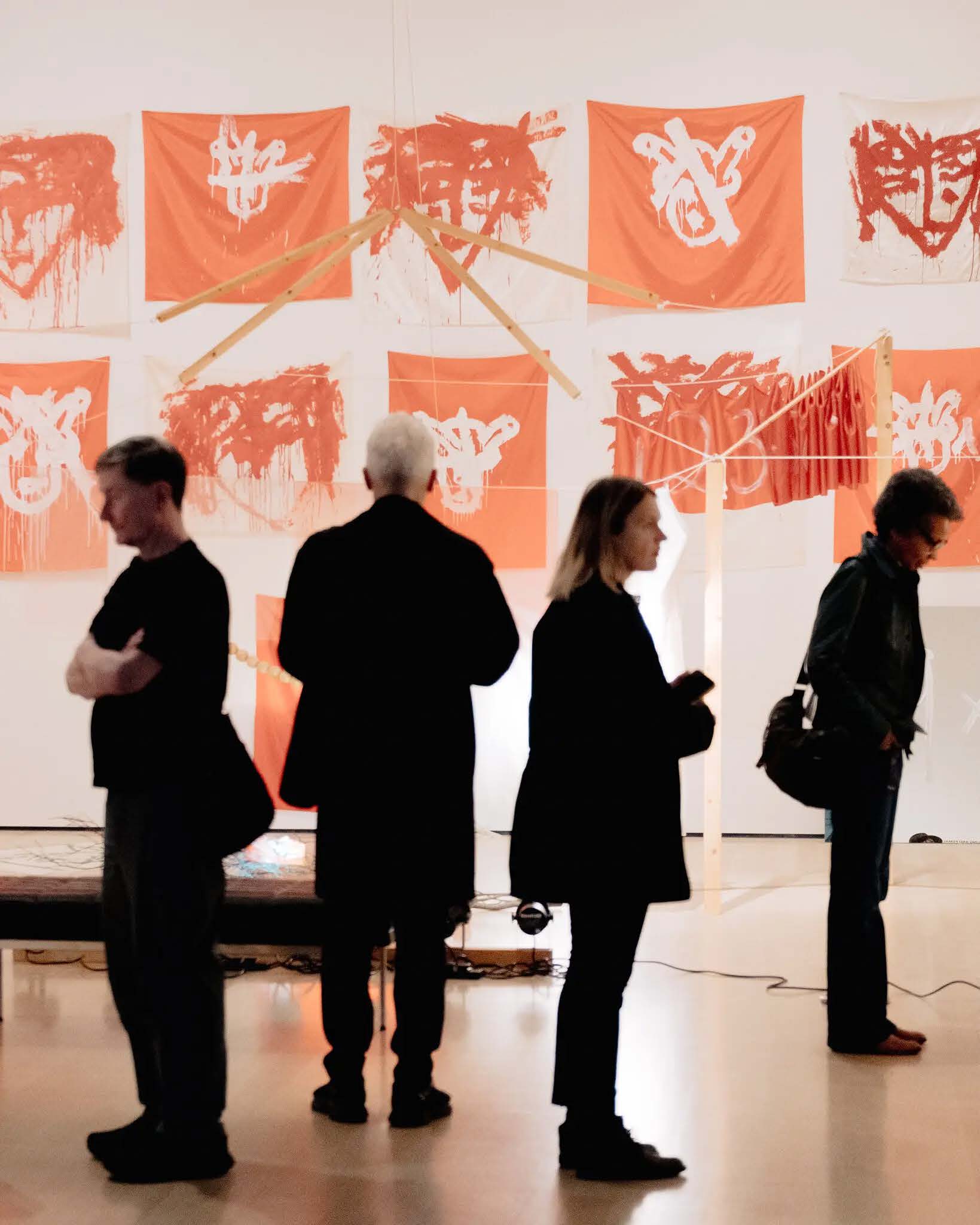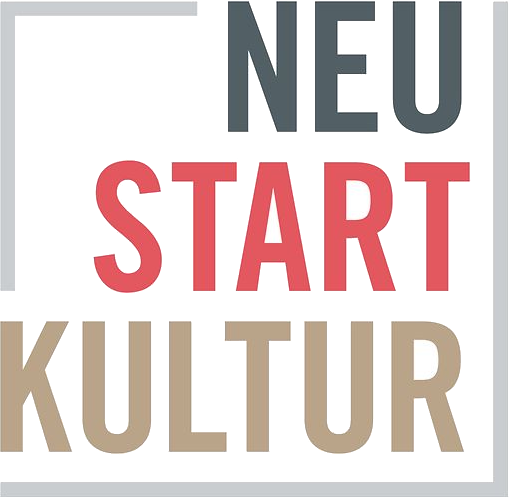„Joan Jonas: A Trailblazer Shines at MoMA“ by Holland Cotter,The New York Times, 20.03.2024
17.03.2024 - 06.07.2024
Solo Show „Joan Jonas. Good Night Good Morning“
MoMA. The Museum of Modern Art, New York

A bounteous and playful survey of the 87-year-old artist’s career on the vanguard highway fills the museum and the
Drawing Center.“
I’m not a humanist, I’m a creaturist. Have been since childhood. The pyramidal view of the world that I grew up with — Man as the crown of creation, with all other animals, four-legged, feathered and scaled, ranked and devalued downward — has never made sense.
Hierarchies in art, with painting and sculpture enthroned at the
top, don’t make sense either. When it comes to form, I’m a pluralist verging on everything-ist. I find too much beauty in too many cultures to be anything else. All materials — from marble, to sweetgrass, to pixels — have equal potential. It’s what’s done with them — physically, expressively, spiritually — that counts.
No American artist better matches my existential and aesthetic proclivities than Joan Jonas, one of the great and still undersung creative figures of our time. A trailblazer in the realms of video, performance, conceptual and installation art, she arrived, more than 60 years ago, at a point on the vanguard highway where the feminist and the early environmentalist movements met, and she has kept moving forward since.
Any art season is bright that brings a consideration of her career, and this spring does, in two enchanting concurrent shows. The artist’s long-overdue first New York retrospective, “Joan Jonas: Good Night Good Morning,” fills the sixth floor of the Museum of Modern Art. And a bounteous survey of her work on paper, titled “Joan Jonas: Animal, Vegetable, Mineral,” is at the Drawing Center in SoHo.
Born in New York City in 1936, Jonas trained as a sculptor, but time spent in the city’s downtown avant-garde art world quickly expanded her ideas not only of what could be sculpture, but of what could be art. The options she spotted — none of which the mainstream art world took seriously at the time — included bodies in motion; images projected on screens; sounds that created moods and defined space; and arrangements of objects — new and old, made and found — that told stories.
In the early 1960s, she began studying with the radical Judson
Dance Theater choreographers Trisha Brown, Steve Paxton and Yvonne Rainer. She also paid close attention to the genderscrambling work of the fringe theater magus Jack Smith, who created, from junk shop pickings, stage sets that were also sculptural environments.
She began performing herself, at first alone in her SoHo loft, then with fellow artists. She eventually bought a video camera, newish technology at the time, and started shooting. As she later said: “I didn’t see a major difference between a poem, a sculpture, a film, or a dance.” And in the MoMA show, which documents more than half a century of her art, she weaves all of these together.
Nature was in the work from the start. Several of the earliest
filmed performances took place outdoors. In the 1968 video titled “Wind” that opens the show a handful of performers, under the artist’s direction, pose and dance on a frigid, snow-covered Long Island beach. The real choreographer, though, is an incoming winter gale so strong it all but knocks them down. Only two figures in the film seem not to struggle. Mirrors attached to their clothing make them look half-transparent, as if the storm could blow, unresisted, through them.
Mirrors, reflecting and refracting reality, became a signature
element of Jonas’s early work. In a 1969 piece set on a tree-shaded lawn at Bard College, performers holding tall, outward-facing mirrors make the audience gathered on the grass and seen in shifting reflection, the real performers.
And in a 1972 video, “Left Side Right Side,” Jonas turns a mirror on herself, abruptly and repeatedly changing its position, in the process doubling her image and dividing it. The suggestion is that self-reflection, physical and psychological, can be both an instrument of self-knowledge but also a source of confusion, the latter evident in her halting efforts to distinguish “left” from “right” when using her mirrored face as a point of reference.
Self-imaging was common practice in early feminist work. Apart from her inclusion in the 2007 survey “Wack! Art and the Feminist Revolution,” Jonas is still seldom mentioned in this political context. But she should be, if for no other work than her 1970s solo performances, live and filmed, as an alter ego named Organic Honey, an “electronic erotic seductress” (Jonas’s words) who is a charismatic but critical embodiment of female creativity and around whom Jonas composed a series of installations.
These walk-in assemblages encompassed prop-like objects
(musical instruments, furniture, masks, rocks, Asian and African textiles), sonic elements (human howls, animal hums, percussive clapping, folk fiddling), videos, prerecorded and live, and at least one live performer, Jonas herself. The multimedia, multidisciplinary format became the model for her subsequent major works, versions of which make up much of the MoMA show, organized by Ana Janevski, a curator in the museum’s department of media and performance, working with the curatorial assistants Lilia Rocio Taboada and Gee Wesley, and Jonas herself.
As is the case with most interesting art, the basic format was
flexible, with plenty of give for rethinking and revising, for adding new things and carrying old ones over into developing versions. (Several installations at MoMA are serially dated, e.g. “1976/1994/2005.”) Such malleability also solves a basic practicalproblem built into performance-centered art: How do you keep it vital when the original performer or performers have stepped away? At 87, Jonas now performs somewhat less regularly than she once did — she’ll be performing three times at MoMA, on March 26 and again in May — but her installations, visually complex and textured, are dynamically personable on their own.
And over time, specific features gained emphasis. One was her use of storytelling. New York’s ’60s avant-garde rejected narrative as reactionary, romantic. But it was always there, submerged, in Jonas’s art, and rose fully to the surface in the “The Juniper Tree” (1976) which comes at about midpoint in the MoMA show.
With its suspended ranks of bannerlike red-and-white paintings and tools and toys for props the installation clearly suggests a stage set. And as the title indicates, the piece has a direct source in literature: a Grimm Brothers fairy tale, one in which birds and humans merge identities.
Animals of various kinds have been a constant presence in Jonas’s art. Portraits of her pet dogs, life companions, recur from the 1970s onward. Of the 300 pieces in the first-ever and heart-liftingly beautiful survey of her works on paper at the Drawing Center almost all depict nonhuman beings — dogs, rabbits, snakes, turtles, insects — based on images seen by Jonas in books or in the wild. (For decades she has lived part of each year in rural Nova Scotia.)
And recent installations at the end of the MoMA show extend the creatural spectrum at the Drawing Center into the ocean and up into the air.
For some time now Jonas has been working with the marine
biologist and environmentalist David Gruber, incorporating his
gorgeous, cautionary films of deep-sea life into her art. Their latest collaboration, commissioned by MoMA, includes a video that plays inside one of Jonas’s several “theater box” sculptures, funnelshaped wooden containers designed for single-person viewing. It documents a rarely recorded event: the birth of a sperm whale, an endangered species, and the tender communal efforts of the entire whale herd to ensure the vulnerable newborn’s survival in its first difficult hours in the world.
Hanging above this piece in the high-ceilinged gallery is another, more abstract image of collective life: a group of large paper and bamboo kites with shapes and colors that bring to mind the avian images in the Drawing Center show. “Soaring like birds,” in Jonas’s description, the kites were made, following folk traditions in Vietnam, and hand-painted by Jonas. They pick up the theme of natural vitality —- the movement of wind and breath —- that runs through the world, and the show, even in the face of a precarious planetary destiny.
In the avant-garde milieu from which Jonas emerged the word
“spiritual” was not admissible, but Jonas, who has traveled globally and experienced art’s many, many forms and uses, isn’t afraid of it. In a 2014 interview with PAJ: A Journal of Performance and Art, she said: “One thing that has come with age is wanting to really think about spiritual matters and concentrate more on things of the spirit. In a way, that’s very down to earth.”
And down to earth is where her art has always been directed, to an earth in which all of us creatures have an equal stake.
Image: Visitors study the multimedia installation “The Juniper Tree” (1976/1994) in the exhibition “Joan Jonas: Good Night Good Morning” at the Museum of Modern Art, which includes
slides and sound. Photo credit: Clark Hodgin for The New York Times.


